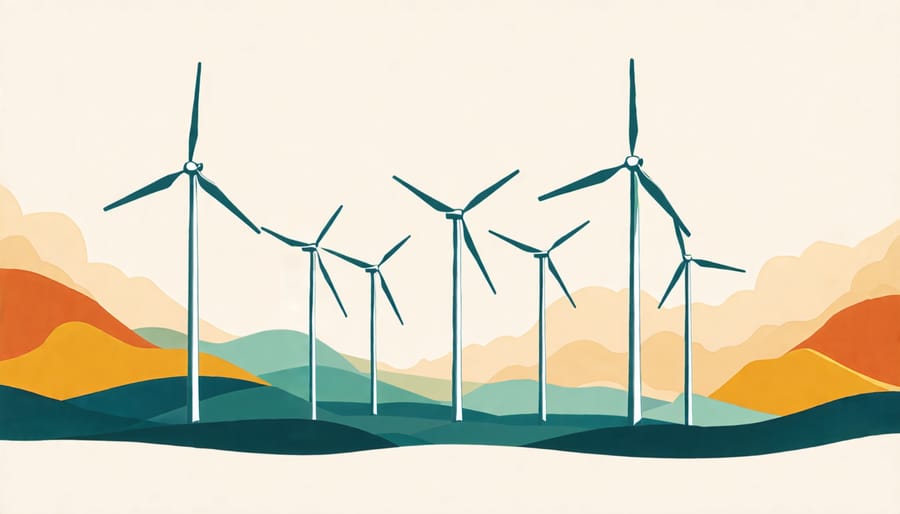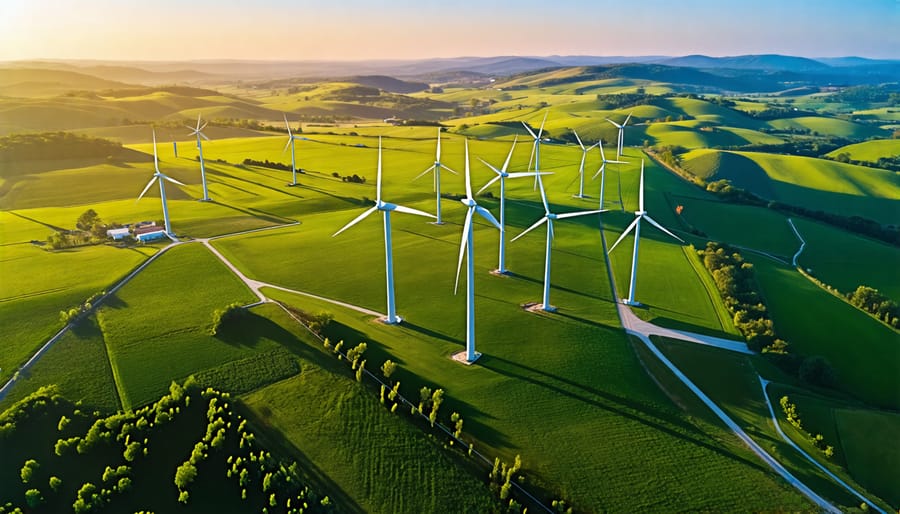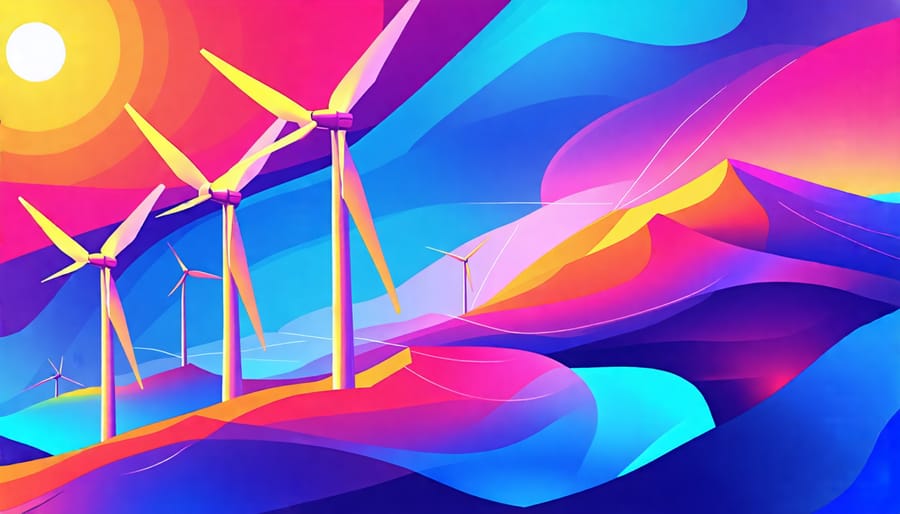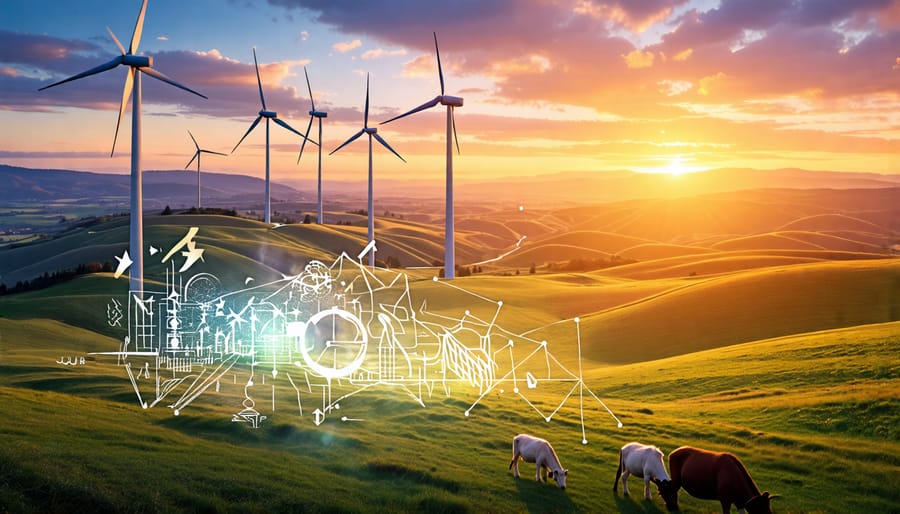Harness the power of the wind by understanding how turbines transform its kinetic energy into electricity. Position turbines strategically in high-wind areas to maximize efficiency, ensuring they capture the strongest and most consistent gusts. Choose appropriate turbine designs, like horizontal-axis or vertical-axis models, based on environmental conditions and project needs. Integrate advanced technologies, such as smart grid systems and predictive maintenance tools, to enhance performance and sustainability. By mastering these steps, you can effectively contribute to a cleaner, renewable energy future while reducing reliance on fossil fuels.
The Basics of Wind Energy
Understanding Wind Power
Wind power is a remarkable example of using natural forces to generate electricity. At its core, wind energy production relies on the idea that moving air—wind—can be harnessed to perform work. Wind turbines, towering structures often seen scattered across fields or coastlines, capture kinetic energy from the wind. The process begins when wind spins the turbine blades, similar to how a pinwheel turns in a breeze. This motion turns a shaft connected to a generator, which then converts the mechanical energy into electricity. Understanding the science behind wind power involves exploring how temperature differences on Earth create air pressure variations, causing winds to blow from high-pressure to low-pressure areas. This natural movement offers a clean and renewable energy source, contributing positively to global sustainability efforts.
History and Evolution
Harnessing the wind’s power is an ancient practice, with historical roots tracing back to 5000 BC when Egyptians used sailboats on the Nile. By the Middle Ages, Europeans adopted windmills to grind grain and pump water, marking a significant evolution in harnessing wind energy for practical uses. This technology laid the foundation for today’s advanced wind turbines. The 19th century saw the first attempts at generating electricity via wind, with Charles Brush developing the first large windmill to produce power in the 1880s. The oil crises of the 1970s reignited interest in wind energy, spurring technological advancements and investment. Today, wind energy is a key player in global renewable energy strategies, celebrated for its efficiency and potential to reduce carbon footprints. The journey from simple sails to sophisticated turbines underscores wind energy’s lasting role in achieving sustainable energy solutions worldwide.
How Wind Turbines Work
Components of a Wind Turbine
Wind turbines are marvels of modern engineering, converting the kinetic energy of wind into electricity. At the heart of a wind turbine are its rotor blades, typically three in number, designed to capture the wind efficiently. These blades act like airplane wings, creating a lift that spins the rotor. Connected to the rotor is the nacelle, which houses essential components such as the gearbox, generator, and various control systems. The gearbox adjusts the rotor’s rotational speed to suit the generator, which then converts mechanical energy into electrical energy.
The tower serves as the backbone of the turbine, elevating the blades and nacelle to optimal heights where wind speeds are stronger and more consistent. Often made of steel, towers can stand hundreds of feet tall, maximizing efficiency. These components work in harmony, adjusting to changes in wind direction and speed using advanced technology, ultimately generating clean, sustainable energy from an abundant natural resource. With every gust of wind, these turbines represent a step towards a greener future.
The Mechanics of Energy Conversion
Wind energy production begins when kinetic energy from the wind turns the blades of a wind turbine. These blades are attached to a rotor, which also begins to spin. This movement transforms wind’s kinetic energy into mechanical energy. Inside the turbine’s nacelle, the rotor is connected to a shaft that leads to a gearbox. The gearbox increases the rotational speed of the shaft, optimizing the efficiency of energy conversion.
This mechanical energy is then transferred to a generator. Inside the generator, coils of wire and magnetic fields interact to convert mechanical energy into electrical energy through electromagnetic induction. The resulting electricity travels through cables to a transformer, which adjusts the voltage for efficient transmission to the power grid.
This elegant process not only captures the free and abundant energy of the wind but also reflects a commitment to sustainable power solutions. As technology advances, wind energy continues to become a more viable and vital part of the global energy mix, supporting a cleaner future.

Types of Wind Turbines
Wind turbines come in different designs, each tailored to harness the power of the wind in unique ways and fit specific applications. The most common type is the horizontal axis wind turbine (HAWT), characterized by its propeller-like blades. These turbines are typically used for large-scale energy production and are often found in wind farms both onshore and offshore. HAWTs are praised for their efficiency and capability to generate significant amounts of electricity.
On the other hand, vertical axis wind turbines (VAWTs) have blades that rotate around a vertical axis, resembling an eggbeater. VAWTs are advantageous for urban environments or areas with turbulent wind conditions due to their ability to capture wind from any direction. Though generally less efficient than HAWTs, they offer easier maintenance as their components are closer to the ground.
Innovative designs are also emerging, such as airborne wind turbines and bladeless versions, promising to revolutionize wind energy by reaching higher altitudes or reducing environmental impact. Each type of wind turbine thus plays a vital role in expanding our renewable energy potential, contributing to a more sustainable future.
Wind Energy Production Process

Site Selection and Preparation
When selecting sites for wind farms, several critical factors are considered to optimize energy production and minimize environmental impact. Firstly, wind speed and consistency are vital; areas with steady, strong winds are ideal. Both elevated terrains and coastlines are often studied for their wind potential. Proximity to existing power infrastructure is another key element, as it affects the ease of integrating the generated electricity into the grid. Additionally, assessing environmental impacts ensures that local wildlife and ecosystems are preserved, particularly in offshore wind farms.
Once a site is deemed suitable, preparation involves land acquisition, securing permits, and working with local communities to address concerns and enhance benefits. Site preparation also entails building access roads, wind turbine foundations, and grid connections. By carefully considering these factors, wind farms can be developed efficiently, contributing to cleaner energy and a sustainable future.
Installation and Setup
The installation of wind turbines begins with site selection, where factors like wind speed, land availability, and environmental impact are assessed. Once a suitable site is chosen, a thorough planning phase is conducted that includes obtaining necessary permits and designing infrastructure like access roads and electrical connections. The site is then prepared, involving grading the land and laying foundations. Transportation of turbine components, such as blades, towers, and nacelles, is a logistical challenge, often requiring specialized vehicles due to their size.
Once on-site, cranes are used to erect the towers, mount the nacelles at the top, and attach the blades. Technicians then complete electrical wiring and systems integration to connect the turbine to the power grid. Modern setups sometimes include installing monitoring systems to optimize performance and efficiency. This meticulous process ensures that wind turbines are well-situated to harness wind energy effectively for a cleaner future.
Energy Generation and Grid Integration
Wind farms are strategically integrated into the power grid to harness and distribute energy. Once turbines convert wind into electricity, this energy is transmitted to substations where it is synchronized and transformed to higher voltage levels suitable for grid distribution. Key challenges arise due to the variability of wind, requiring advanced forecasting and storage solutions to balance supply with demand. Grid operators implement smart grid technologies to optimize energy flow and maintain stability. Notable success stories, such as Denmark’s grid, demonstrate innovative grid designs that harmonize wind energy with other renewable sources, enhancing reliability. Collaborative efforts among engineers, policymakers, and technology firms are vital to overcoming the inherent unpredictability, ensuring that wind energy remains a reliable component of the sustainable energy mix.
Maintenance and Monitoring
The efficient operation of wind farms hinges on the diligent upkeep and constant monitoring of turbines. Regular maintenance not only extends the life of these complex machines but also optimizes their energy output. Innovations in real-time monitoring technology allow operators to detect potential issues before they arise, minimizing downtimes and enhancing productivity. These sensors track key metrics such as vibration levels and temperature, providing invaluable data to anticipate and address maintenance needs. The importance of maintenance is exemplified in various case studies where proactive strategies significantly reduced operational costs and boosted energy yield. By ensuring that turbines are in peak condition, wind farms can continue to be an integral part of our sustainable energy future, ultimately contributing to a greener planet.

Benefits and Challenges of Wind Energy
Environmental and Economic Benefits
Wind energy plays a crucial role in reducing carbon emissions, thus significantly mitigating climate change. By harnessing the power of the wind, we can generate clean, renewable energy that doesn’t rely on the burning of fossil fuels, which are a major source of greenhouse gases. Furthermore, the wind industry fuels economic growth by creating jobs in manufacturing, installation, and maintenance of wind turbines. For instance, communities hosting wind farms often benefit from increased local employment opportunities and associated economic development. As a result, wind energy not only promotes a healthier environment but also bolsters sustainable economic progress.
Challenges and Solutions
Producing wind energy faces challenges like inconsistent wind patterns, which can affect energy output. Solutions include strategic placement of turbines in high-wind areas and the development of advanced forecasting tools. Another barrier is the impact on local wildlife, particularly birds. This can be mitigated by careful site selection and innovative turbine designs that minimize harm. Noise pollution is also a concern; implementing quiet technology can help. Finally, high initial costs deter investment, but with improvements in technology and policy incentives, costs are falling. These solutions highlight the potential for wind energy to become a key player in sustainable power generation.
Real-Life Case Studies and Innovations
Case Study: Denmark’s Wind Energy Success
Denmark stands as a global leader in wind energy, a beacon of how visionary policies and community support can drive renewable energy success. As of recent years, wind energy supplies nearly half of Denmark’s electricity needs, showcasing a seamless integration into its national grid. This achievement didn’t happen overnight; it is the result of decades of commitment, starting in the 1970s. Government policies provided robust incentives for wind energy development, fostering a collaborative environment where communities and cooperatives could invest in wind farms. Denmark’s strides have been propelled by innovative technologies and public engagement, creating a model for energy transition. This success story not only highlights the technical feasibility of widespread wind energy adoption but also serves as an inspiring roadmap for other nations aiming for sustainable energy solutions.
Innovations Shaping the Future
Wind energy is evolving rapidly, driven by the latest innovations in technology and design. Floating wind turbines are revolutionizing offshore capabilities, allowing access to stronger and more consistent winds found far from shores. These floating giants are paving the way for more reliable and efficient energy output. On land, the integration of artificial intelligence and advanced data analytics is optimizing turbine performance and maintenance, reducing costs and increasing lifespan. Furthermore, small-scale vertical axis wind turbines are being developed for urban settings, making wind energy accessible in cities. Nations are collaborating on smart grids to seamlessly integrate wind power with other renewable sources, ensuring a stable and sustainable energy future. As these advancements gain momentum, wind energy is set to become a cornerstone of global renewable energy strategies.
Conclusion
Throughout this exploration of wind energy, we have delved into the transformative potential that this renewable resource offers for our global energy landscape. By harnessing the power of wind, we can significantly reduce our reliance on fossil fuels and move towards a more sustainable and clean energy future. Wind energy not only decreases carbon emissions but also boosts local economies by creating jobs and fostering technological innovation. The stories of communities that have successfully integrated wind power into their energy mix serve as inspiring examples of what can be achieved with commitment and forward-thinking policies. Through expert insights, we’ve gained a comprehensive understanding of the advances in turbine technology, grid integration, and storage solutions that make wind an increasingly viable and attractive option. As we look to the future, embracing wind energy can play a crucial role in addressing climate change and securing a stable energy supply. Our journey underscores the importance of continued support and investment in this powerful and endlessly renewable resource.





